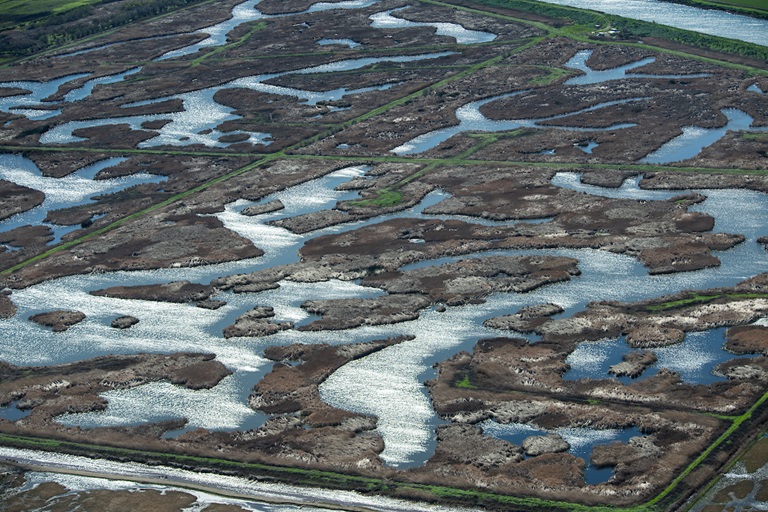DWR Enters ‘Whale’s Belly’ to Combat Climate Change, Protect Water Deliveries
Aerial view of wetlands on Sherman Island in part of the Sacramento-San Joaquin River Delta in Sacramento County, California. DWR photo.
A marshy tract known as Sherman Island is one of the most sensitive and geographically important locations for water conveyance in California. On May 11, DWR began a restoration project on the southeast side of the island that combats climate change while protecting statewide water supply.
The 10,000-acre Sherman Island, which sits at the confluence of the Sacramento and San Joaquin rivers between the cities of Rio Vista and Antioch, has sunk up to 20-feet below sea level since the Gold Rush due to evaporating peat soils. This sinking of land – a process known as subsidence –strains levees that protect Sherman and nearby Delta islands.
If multiple levees were to fail at once, river flows would rush to fill in the bowl-shaped Sherman Island and neighboring islands. This would allow San Francisco Bay seawater to infiltrate the interior Delta. The essential freshwater moving through the Delta and delivered by the State Water Project would become compromised or unconsumable with salinity, threatening public safety, water supply and economic health.
Since the 1990s, a coalition of state and local partners, including DWR and The Delta Conservancy, have studied the benefits of controlled flooding on deeply subsided Delta islands. When a Delta island is inundated with a few feet of water, it creates marshland that stops peat soils from oxidizing and sinking. Eliminating subsidence helps protect the structural integrity of levees. Moreover, the restored marshland curbs naturally-occurring greenhouse gas emissions.
“DWR and our partners are showing that the confluence of community flood protection, climate resilience, water security, and ecosystem restoration is both possible and replicable.” said Kristopher Tjernell, DWR’s Deputy Director of Integrated Watershed Management.
“It’s our hope that this and similar projects help show the way to a more sustainable Delta for generations to come.”
The Whale’s Belly Wetland Restoration Project expands DWR’s pilot Delta Carbon Program, a carbon sequestration effort, by trapping water across approximately 1,000 acres and reestablishing marshland on Sherman Island. The effort follows recommendations in Gov. Gavin Newsom’s draft Water Resilience Portfolio to eliminate subsidence-inducing practices on state-owned land in the Delta.
“The Whale’s Belly project marks the beginning of a groundswell for stopping subsidence and stopping carbon emissions from the Delta,” said Campbell Ingram, executive officer of The Delta Conservancy. “We’re making real progress.”
The Whale’s Belly Wetland Restoration Project builds DWR’s carbon sequestration portfolio to 3,300 acres. Every acre of peat soil that is intentionally flooded in the Delta prevents between 10 and 20 tons of carbon dioxide released into the air each year.
DWR, The Delta Conservancy, and other partners like HydroFocus Inc. have developed a carbon sequestration protocol that allows wetland landowners to sell carbon credits in a voluntary cap-and-trade market. The Whale’s Belly Wetland Restoration Project further demonstrates how wetland conversion provides a variety of public benefits and protects the regional and statewide economy.
Whale’s Belly is part of the California EcoRestore Initiative to restore and protect at least 30,000 acres of habitat across the Sacramento-San Joaquin Delta. EcoRestore takes on big, bold projects with as many benefits as possible for people, fish and wildlife. Beyond combatting climate change and Delta subsidence, the project improves habitat for millions of migrating birds along the Pacific Flyway that rely on the Delta as a crucial rest stop and safe haven on their journey. Whale’s Belly is one of four projects on Sherman Island that creates managed wetlands, tidal wetlands and setback levees to contribute toward EcoRestore’s restoration targets.
“This is cutting-edge science,” said Bryan Brock, DWR Senior Engineer. “Through many years of study, we have proven that strategically flooding islands and allowing growth of marshlands halts subsidence and sequesters the carbon that contributes to greenhouse gas emissions. The continuous commitments and efforts of DWR and our partners are paying off.”
The $7 million Whale’s Belly Wetland Restoration Project includes adding soils and materials to support protective levees and riverbanks, enabling these structures to effectively hold back high floodwaters. Construction will also involve relocation of drainage ditches, pipelines and water pumps. Upon completion of construction activities, the island will be filled with approximately one-to-three feet of water, allowing marshland growth to eliminate subsidence on this southeast section of Sherman Island.
The project is scheduled for completion by fall 2021. It is funded by the Wetland Restoration for Greenhouse Gas Reduction Fund, a program managed by the California Department of Fish and Wildlife.
